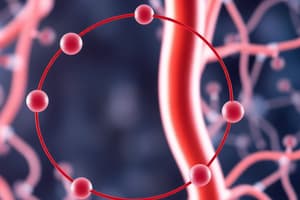Podcast
Questions and Answers
What is the biological process by which organisms exchange oxygen for carbon dioxide?
What is the biological process by which organisms exchange oxygen for carbon dioxide?
- Respiration (correct)
- Circulation
- Photosynthesis
- Digestion
Which part of the human body receives blood from the pulmonary circulation?
Which part of the human body receives blood from the pulmonary circulation?
- Heart (correct)
- Stomach
- Liver
- Kidneys
What is the average human breath volume known as?
What is the average human breath volume known as?
- Maximum capacity
- Lung capacity
- Vital capacity (correct)
- Total capacity
Which muscles are responsible for facilitating the inhalation and exhalation of air?
Which muscles are responsible for facilitating the inhalation and exhalation of air?
What can interruption of respiration due to asphyxiation, drowning, or chest muscle paralysis lead to?
What can interruption of respiration due to asphyxiation, drowning, or chest muscle paralysis lead to?
Which process combines oxygen with food molecules to release energy for cellular processes?
Which process combines oxygen with food molecules to release energy for cellular processes?
What is the main purpose of the TCA cycle?
What is the main purpose of the TCA cycle?
How many steps are involved in the TCA cycle?
How many steps are involved in the TCA cycle?
What is the waste product produced during the TCA cycle?
What is the waste product produced during the TCA cycle?
Which molecules are produced by the TCA cycle and used in oxidative phosphorylation?
Which molecules are produced by the TCA cycle and used in oxidative phosphorylation?
In oxidative phosphorylation, hydrogen atoms are removed from which molecules?
In oxidative phosphorylation, hydrogen atoms are removed from which molecules?
Why is respiration considered essential in the Earth system?
Why is respiration considered essential in the Earth system?
Flashcards are hidden until you start studying
Study Notes
Respiration: The Process of Exchanging Oxygen and Carbon Dioxide
Respiration is the biological process by which organisms exchange oxygen for carbon dioxide through the process of inhalation and exhalation. The human respiratory system, responsible for this crucial process, consists of the lungs and the thoracic cage that houses them. The lungs receive blood from the pulmonary circulation, which carries carbon dioxide from the body tissues to be exhaled and picks up oxygen from the alveoli in the lungs for distribution to the heart and the rest of the body.
Anatomy and Function
The average human breath, known as tidal volume, amounts to approximately one-eighth of the total lung capacity, or vital capacity. The respiratory muscles, including the diaphragm and chest wall muscles, are controlled by nerve centers in the brain and facilitate the inhalation and exhalation of air.
Consequences of Respiratory Disorders
Interruption of respiration for extended periods due to asphyxiation, drowning, or chest muscle paralysis can lead to death, as the human body stores minimal oxygen. Disorders affecting respiration include allergies, asthma, bronchitis, emphysema, pneumonia, and tuberculosis.
The Tricarboxylic Acid Cycle (TCA Cycle)
Cellular respiration is the process by which organisms combine oxygen with foodstuff molecules to release energy, which is then used to power various cellular processes. The TCA cycle, also known as the Krebs or citric acid cycle, plays a central role in the breakdown of organic fuel molecules and releases energy in the form of ATP.
During the TCA cycle, which consists of eight steps catalyzed by eight different enzymes, carbon dioxide is produced as a waste product. The TCA cycle produces NAD+ and FADH2 molecules, which are used in the next stage of cellular respiration, oxidative phosphorylation.
Oxidative Phosphorylation
Oxidative phosphorylation is the stage of cellular respiration where energy is conserved and released in the form of ATP. In this stage, pairs of hydrogen atoms are removed from NADH and FADH2 molecules, which then donate their electrons to a series of iron-containing hemoproteins called cytochromes. These electrons are eventually transferred to oxygen, forming water.
Respiration is an essential part of the Earth system, as it releases energy stored in organic molecules and produces carbon dioxide and water. Most organisms on land, freshwater, and the oceans, including plants, use cellular respiration to extract the energy they need to function, grow, and reproduce.
Studying That Suits You
Use AI to generate personalized quizzes and flashcards to suit your learning preferences.




